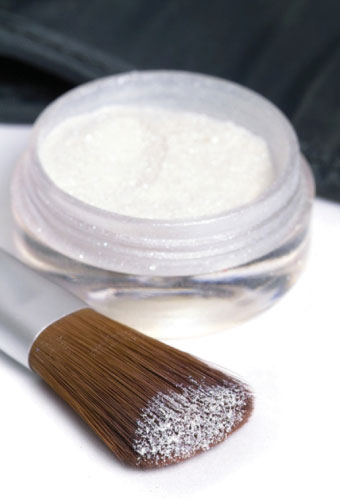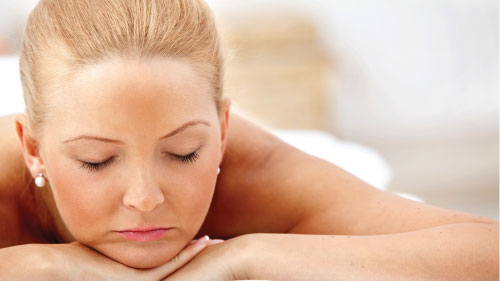Beautiful Skin Starts from Within
Remember, one of the functions of the skin is elimination. If we do not make healthy eating choices today, our skin may reflect it tomorrow. The Greek physician Hippocrates (460 - 377 BC), often referred to as the "Father of Modern Medicine," was an herbalist; one of his famous statements is "Let your food be your medicine, and your medicine be your food."
Oxidative stress, along with inflammation, are the main reasons for premature skin aging and discolorations. Every day our skin encounters free radicals in many different forms; environmental pollutants, ultraviolet rays, poor diet, emotional stress, etcetera. We need antioxidants to protect our cells from the damaging effects of oxidation. Here is a short list of just a few antioxidants that can help repair our bodies and improve our skin on the cellular level:
Proanthocyanidins: Called OPC's for short, these antioxidants reduce free radicals and help restore sun damaged and aging skin. They also help strengthen capillaries and give red and blue fruits their color. Foods we can eat that are rich in OPCs include: raisins, grapes, bilberries, cranberries, black currants, green tea, cocoa, and grape seeds.
Glutathione: (GSH) has been called the master antioxidant. “It is well known that aging is accompanied by a precipitous fall in GSH levels. Lower GSH levels are implicated in many diseases associated with aging, including cataracts, Alzheimer’s disease, Parkinson’s, atherosclerosis, and others.” (Journal of Clinical Epidemiology 47: 1021-26 1994). In their book, The Immune System Cure, Lorna R. Vanderhaeghe and Patrick J.D. Bouic, Ph.D. state: “No other antioxidant is as important to overall health as glutathione. It is the regenerator of immune cells and the most valuable detoxifying agent in the body. Low levels are associated with early aging and even death. Glutathione can be found in goat's milk, whey protein, asparagus, avocado, parsley, and broccoli.
Polyphenols: These micronutrients represent a large category of antioxidants. According to an article in the American Journal of Clinical Nutrition (Vol. 81, No. 1, 215S-217S, January 2005) more evidence shows that these compounds can help prevent the spread of a number of degenerative conditions. Most of fruits and vegetables contain some polyphenols, including green and black tea, red wine, onions, broccoli, greens, apples and blueberries.
Carotenoids: We have been hearing more about these fat-soluble micronutrients. One type of carotenoid, beta-carotene, is known for its ability to convert into vitamin A in the body. This enhances immune system function and helps protect cells from DNA damage. We can benefit from them by including red, orange, dark green, and yellow fruits and vegetables into our diets like sweet potatoes, apricots, peaches, carrots, cantaloupe, pumpkin, and tomatoes.
The Amazing Chaga Mushroom
An exotic whole food source of antioxidants is the Siberian Chaga or "Birch mushroom." This fungus contains some of the most powerful antioxidants known. Over the centuries it is been called "A Gift from God" and "The Mushroom of Immortality.” It is considered the champion of antioxidants, and its potency far outstrips pomegranates, Acai berries, or blueberries.
The most potent Chaga in the world is produced in the cold reaches of Siberia. It appears as a black, irregular, cracked mass that grows on Birch tree trunks. It is not cultivated, but wild-crafted.
Chaga Mushroom has the highest Oxygen Radical Absorbance Capacity (ORAC) score for natural foods or supplements as tested by the USDA and Tufts University. The ORAC test is currently the standardized method used by the USDA for measuring the antioxidant capacities of different foods and supplements. This test measures the "power" of foods to neutralize free radicals and create balanced healthy cells.
Chaga Mushroom has been used in Russia by dermatologists and aestheticians in topical preparations to fight skin infections, wrinkles, hyperpigmentation, premature aging, sun damage, spider veins, broken capillaries, scars, cellulite, and stretch marks. Chaga tea is commonly used in Russia to support a healthy immune system. Many Russians drink Chaga tea daily. They follow an ancient tradition: In the 12th Century, Tzar Vladimir Monamah was reportedly treated with Chaga to maintain his health.
Probiotics
Probiotics are friendly bacteria that help us digest our food. After being treated with antibiotics, eating processed foods, and the constant use of antibacterial soaps, many of us have stripped our bodies of these very important "digestive helpers." A probiotic deficiency can lead to an imbalance in the digestive system, yeast overgrowth, and toxicity in the body and the skin. All of this disharmony can be reflected in the skin.
That is why holistic skin care practitioners advise people with problem complexions to avoid processed foods and foods with high sugar and starch contents which feed Candida or other yeast overgrowth, while increasing their intake of organic cucumbers and green leafy vegetables.
We need to replenish our body with probiotics and enzymes on a regular basis with cultured foods like sauerkraut, yogurt, kefir, miso soup and kombucha tea. Many people have difficulty digesting cow’s milk and do not use dairy products. I agree with many naturopathic doctors, who suggest using yogurt from goat’s milk instead. Vegans can substitute cultured oats or rice milk.
Weeds for Health and Beauty
A common weed, the dandelion (Taraxacum officinale), which we usually try to clear from our yards, can help correct skin problems. Tea brewed from dandelion roots has traditionally been used by many cultures to cleanse the body. After all, the cleaner our bodies are inside, the better our skin will look!
Moreover, the roots and leaves of dandelion are extremely nutritious and are a valuable source of minerals (especially potassium), as well as vitamins A, B, C, and D. Sap or milk from dandelion stems has been used traditionally for many years around the world to lighten pigment spots and eliminate warts.
Burdock (Arctium lappa), another famous weed, can be combined with dandelion tea to create a powerful cleansing and healing tonic. Burdock is a favorite among herbalists to treat acne. In Japan, burdock root is called gobo and is eaten as a vegetable. Burdock root is low calorie and rich in fiber, potassium, calcium, and amino acids. Both dandelions and burdock can usually be found in Asian grocery or health
food stores.
 Skin Care and Traditional Chinese Medicine
Skin Care and Traditional Chinese Medicine
With a history of over 2,000 years, Traditional Chinese Medicine (TCM) revolves around the premise that the human body is a small universe with a set of complete and interconnected systems. Medicinal plants and minerals are used together with acupuncture and a special diet to establish the balance and harmony in the body. Chinese herbs are classified into categories like cooling, heating, drying and moistening, relaxing, and energizing.
At the age of 74 Empress Tsu Shi was known for her smooth, radiant skin. The key to her beautiful skin? Pearl powder which she is said to have used every day. This secret pearl powder formula was passed on from generation to generation.
As it turns out, pearls are a great source of amino acids, mucopoly-saccharides, proteins, B-vitamins, and minerals including calcium and magnesium. According to ancient texts and records, pearls have been used for medicinal purposes from China for over 2,000 years. They have been used for medicinal purposes to treat certain diseases, as well as to preserve a youthful appearance.
Gold was also considered a key to youth in ancient Chinese medicine. Tradition has it that the queen of the Ch’ing dynasty used a gold massage roller on her face every day. And in ancient Egypt Cleopatra is said to have slept in a golden mask to rejuvenate her skin. In fact, gold facials are being offered today with the promise of firmer skin and wrinkle reduction.
Ayurvedic Tradition and Skin Care
Ayurveda originated in ancient India over 5,000 years ago. In Sanskrit, the ancient language of India, ayurveda means the “science of life and longevity.” Like many other healing traditions, ayurveda addresses skin problems with detoxification of the body. Cleansing can start by simply drinking herbal teas that include licorice, yellow dock, sarsaparilla, and dandelion root.
From an ayurvedic perspective, health is a balance between three basic energies that make up a person’s constitution: vata, pitta, and kapha. Together these energetic forces make up each person’s “Tridosha” which governs all biological, physiological, and psychological functions of the mind and body. Vata skin is dry, pale, thin, and prone to premature wrinkles. It represents the air element and when vata is out of balance it leads to dry skin. Vata skin will benefit from a simple regiment that includes
cleansing with organic goat milk or heavy cream. Exfoliation can be done with almond meal and a few drops of lemon juice to avoid excessive abrading. Vata skin can be nourished with rich oils like sesame or avocado, or with a few drops of sandalwood or rose essential oils.
Pitta skin is sensitive combination skin prone to redness. Because of its fiery nature, pitta skin is sensitive and should be treated delicately. Pitta skin can be cleansed with organic heavy cream mixed with finely ground almonds. It is best nourished with almond, coconut, or olive oils, along with a few drops of Neem oil or jasmine essential oil.
Kapha skin is oily with large pores; it is thick and soft and acne prone. When kapha is out of balance, the metabolism slows down and the body releases more toxins through the skin. A person with kapha skin will benefit by cleansing with organic buttermilk or plain yogurt. Scrubbing the face with chickpea or lentil flour mixed with water will exfoliate and remove dirt from the skin without completely stripping it of moisture. This skin type can be nourished with sunflower or safflower oil, along with essential oils of rosemary and bergamot.
A detoxifying mask that is good for kapha skin: Combine ½ teaspoon of turmeric and ½ teaspoon of bentonite clay with 1 teaspoon water. Turmeric kills bacteria and reduces inflammation, while the clay absorbs oils and toxins.
 Ayurvedic tradition includes daily self body massages with organic cold-pressed oils. Ayurvedic practitioners believe this practice helps nourish the skin and balance the body. It also improves circulation and overall vitality.
Ayurvedic tradition includes daily self body massages with organic cold-pressed oils. Ayurvedic practitioners believe this practice helps nourish the skin and balance the body. It also improves circulation and overall vitality.
Russian Health and Beauty Traditions
Russian holistic traditions run very deep. Many Russian medical schools offer herbal classes. As a holistic skin care practitioner who comes from Russia, I believe in non-invasive methods for corrective, anti-aging skin care treatments. I also recommend the use of individualized skin care protocols that consider nutrition, emotional balance, and lifestyle choices. The therapeutic use of plants and minerals are important elements of professional skin and body care protocols
in Russia.
Steaming Toxins Away
An old Russian proverb advises that a day in the banya (Russian steam bath) is a day without aging! Steaming is an effective way to remove fat-stored toxins from the body. The hottest Finnish saunas used today have low humidity allowing temperatures as high as 200 degrees Fahrenheit. Turkish baths have nearly 100 percent humidity and are maintained at lower temperatures, usually 100 degrees Fahrenheit. Most Russian baths have moderate humidity and heat.
At a Russian banya when you feel it is too hot, you take a dip into a swimming pool with very cold water. While the ice-cold temperature comes as a bit of a shock to the body, people endure it to experience the Russian bath to the fullest.
Russians will drink hot herbal tea at the banya to help release more toxins. Another essential part of Russian banya is venik massage. Leafy, fragrant bundles of birch or oak tree twigs called veniks, are dipped in water, shaken above a warm stove and then used to gently stroke, brush, and tap the body from neck to toes.
Other types of veniks are made from eucalyptus and fir tree branches - even stinging nettles! Venik massages are followed by an intense herbal honey rub to rejuvenate the skin and purify the body. Honey has been proven to be beneficial for the skin. Indeed, a 2004 study conducted by the University of California concluded that honey is rich in antioxidants, and minerals. Honey enzymes also have natural antibacterial activity.
Traditional Russian facials include herbal steaming, the use of compresses steeped in aromatic organic tea, deep cleansing, and extractions, along with freshly prepared herbal and mineral scrubs and masks. A favorite mineral in Russia, actually it is a natural fossilized resin, is Baltic amber.
The beneficial effects of Baltic amber for health and beauty have been known for thousands of years. Hippocrates, the famous father of medicine, described application methods for Baltic amber in his works. Amber contains 3 to 8 percent amber acid, also known as succinic acid, a powerful antioxidant.
I am so happy to see more skin care professionals take a more holistic approach to their practices and offer services that not only beautify, but benefit the entire body. A movement towards a healthier, holistic approach to skin care is well on its way.
There are so many simple, yet effective ways to start incorporating holistic traditions into your aesthetic practice. You can start by simply using organic cotton balls and towels. You can also offer your clients herbal tea or refreshment waters made with fruits and vegetables. It is so easy to put slices of alkalizing cucumber in a pitcher of water, or combinations of other fruits or vegetables. As you incorporate more holistic procedures into your practice your clients will appreciate you even more, while you do your part to make the world a better place!
Elina Fedotova is a cosmetic chemist, herbalist, and licensed aesthetician who uses the intelligence of nature to heal, restore, and beautify the skin. She is the CEO of Elina Organics, and the founder and president of the Association of Holistic Skin Care Practitioners.
